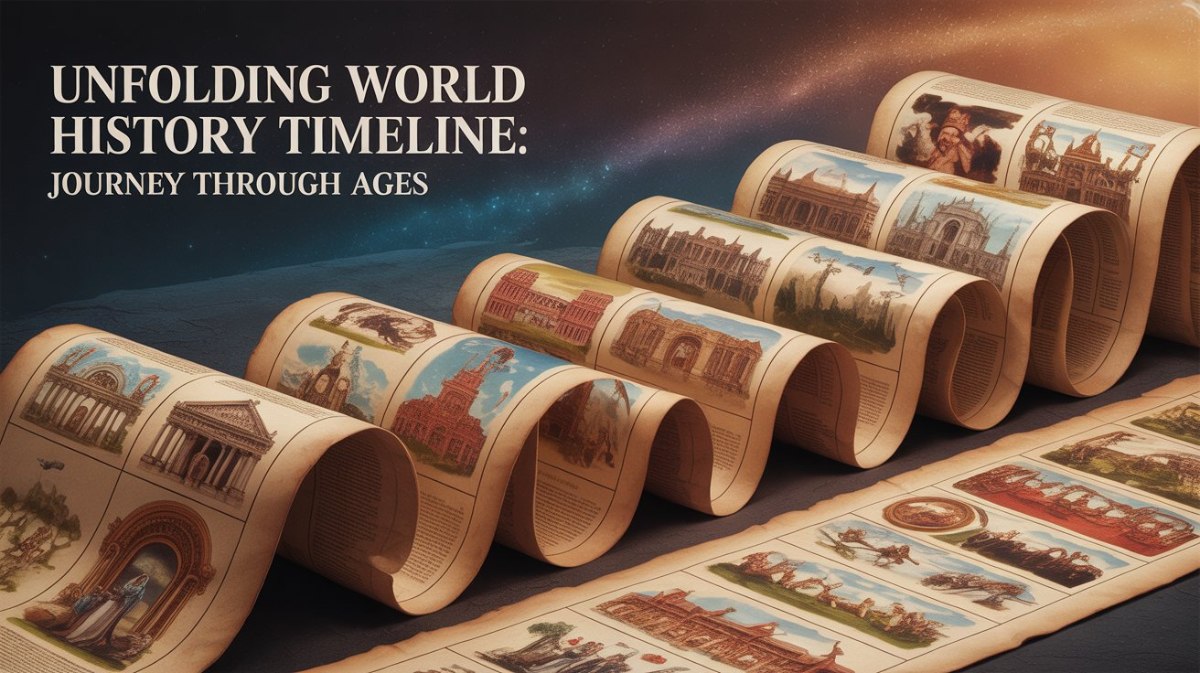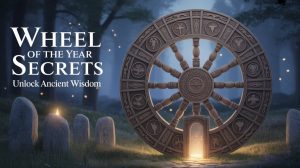The story of humanity is vast, complex, and fascinating. From the first appearance of Homo sapiens to the modern digital age, unfolding World History Timeline reflects our shared struggles, triumphs, and evolution. Each era—prehistoric, ancient, medieval, early modern, and modern—marks turning points that have shaped societies, ideologies, and the global order.
In this guide, we’ll unfold World History Timeline step by step, highlighting pivotal moments, influential civilizations, and events that changed the course of humanity. Whether you’re a student, history enthusiast, or lifelong learner, this timeline will help you understand how the past connects to our present and future.
unfolding World History Timeline Key Eras
| Era | Time Period | Key Highlights |
|---|---|---|
| Prehistoric Era | Before 3000 BCE | Homo sapiens, cave art, Neolithic Revolution |
| Ancient History | 3000 BCE – 500 AD | Early civilizations, Roman Empire, rise of religions |
| Medieval Era | 500 AD – 1500 AD | Islam, Crusades, Black Death, Fall of Constantinople |
| Early Modern Era | 1500 AD – 1800 AD | Renaissance, Reformation, Enlightenment, colonization |
| Modern Era | 1800 AD – Present | Industrial Revolution, World Wars, Cold War, globalization |
1. Prehistoric Era (Before 3000 BCE)

The Prehistoric Era (Before 3000 BCE) marks the earliest phase of unfolding World History Timeline, long before the invention of writing. During this time, humans lived as hunter-gatherers, relying on nature for survival. With the emergence of Homo sapiens, the development of tools, and the creation of cave art, humanity began to express its creativity and intelligence. This era also witnessed the Neolithic Revolution, during which the development of farming and the establishment of permanent settlements laid the groundwork for the emergence of future civilizations.
Key Events
- 300,000 BCE – Appearance of Homo sapiens: Anatomically modern humans emerged in Africa.
- 200,000 BCE – Out of Africa Migration: Early humans spread across continents.
- 50,000 BCE – Cave Art: Art in Lascaux (France) and Altamira (Spain) reflects creativity and symbolic thought.
- 10,000 BCE – Neolithic Revolution: Farming begins in the Fertile Crescent, marking the shift from nomadic to settled societies.
Why it matters: This period shaped human survival strategies, cultural expression, and the foundations of civilization.
2. Ancient History (3000 BCE – 500 AD)
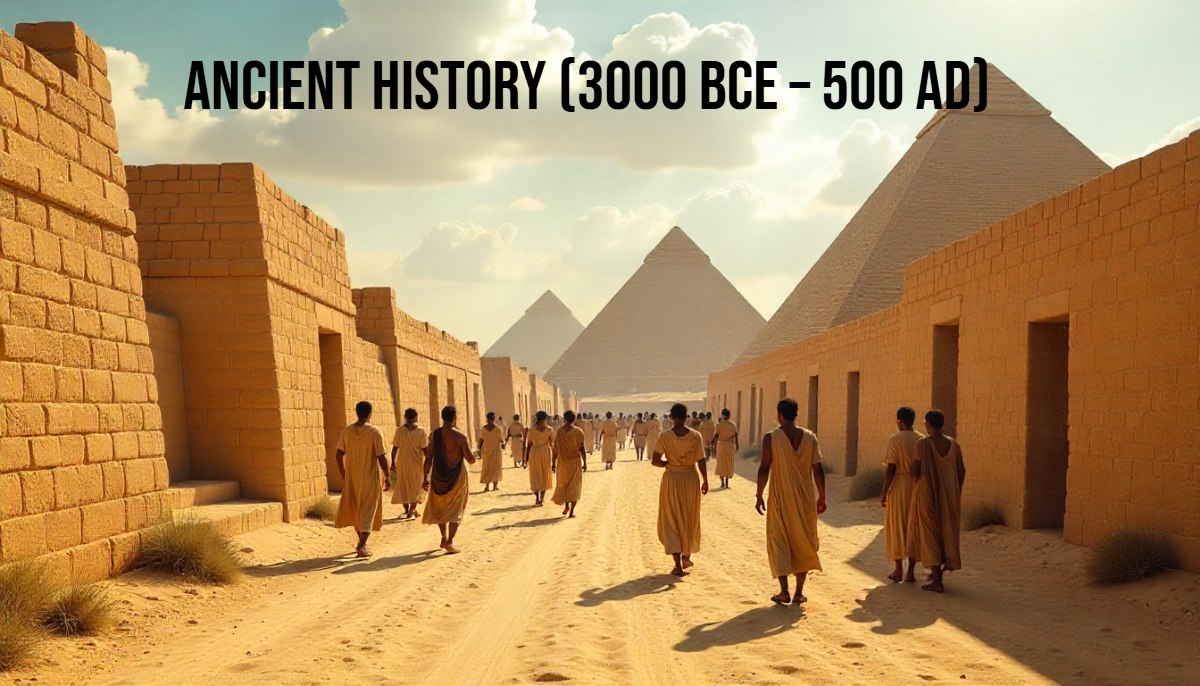
The Ancient History (3000 BCE – 500 AD) period marks a transformative stage in unfolding World History Timeline, when the first great civilizations emerged. Mesopotamia introduced the earliest writing system, while Egypt flourished with its pharaohs and pyramids. The Indus Valley showcased advanced urban planning, and China developed strong dynasties and philosophies. This era was characterized by the emergence of organized states, mighty empires, and enduring cultural traditions that continue to shape societies to this day.
Early Civilizations (3000 BCE – 1000 BCE)
- 3000 BCE – Sumerian Civilization develops cuneiform writing.
- 3000 BCE – Ancient Egypt unites under pharaohs.
- 2600 BCE – Indus Valley Civilization thrives in South Asia.
- 1800 BCE – Code of Hammurabi: Babylon establishes one of the earliest legal codes.
Classical Civilizations (1000 BCE – 500 AD)
- 776 BCE – First Olympic Games in Greece.
- 753 BCE – Foundation of Rome.
- 500 BCE – Greek Democracy emerges in Athens.
- 334–323 BCE – Alexander the Great’s conquests spread Hellenism.
- 27 BCE – Roman Empire begins under Augustus.
- 4 BCE – Life of Jesus Christ, leading to Christianity.
Other Major Civilizations
- 550 BCE – Persian Empire under Cyrus the Great.
- 490 BCE – Battle of Marathon during the Greco-Persian Wars.
- 4th Century BCE – Maurya Empire unifies India; Ashoka spreads Buddhism.
- 313 AD – Edict of Milan legalizes Christianity in Rome.
- 476 AD – The decline of the Western Roman Empire marks the end of Antiquity.
3. Medieval Era (500 – 1500 AD)
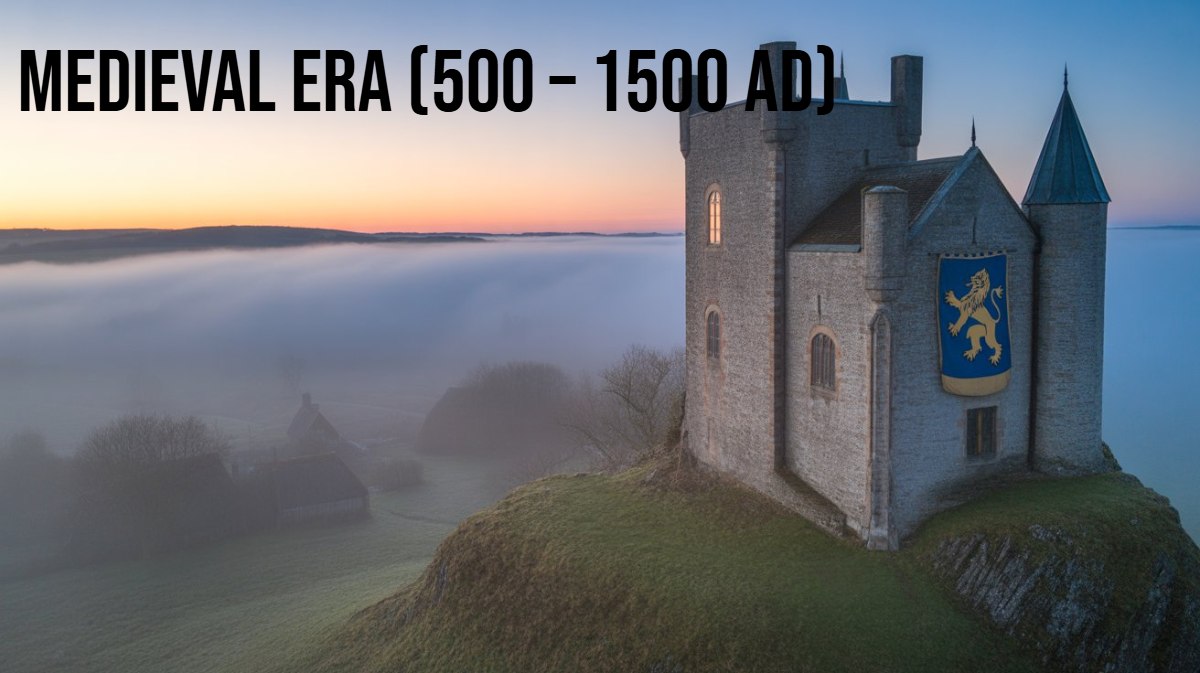
The Medieval Era (500–1500 AD) represents a pivotal stage in world history, often referred to as the Middle Ages. Following the decline of the Western Roman Empire, Europe transitioned into a feudal system while powerful kingdoms and empires rose across Asia and the Middle East. The spread of primary religions, such as Christianity and Islam, significant cultural exchanges through trade and exploration, and transformative events, including the Crusades, the Black Death, and the rise of universities, marked this period.
Early Medieval (500 – 1000 AD)
- 500 AD – The Byzantine Empire preserves the Roman legacy.
- 570–632 AD – Prophet Muhammad establishes Islam.
- 732 AD – Battle of Tours halts Islamic expansion in Europe.
High Middle Ages (1000 – 1300 AD)
- 1066 AD – Battle of Hastings establishes Norman rule in England.
- 1095–1291 AD – Crusades reshape Christian-Muslim relations.
- 1215 AD – Magna Carta limits the monarchy in England.
- 1271–1295 AD – Marco Polo travels to China, boosting East-West trade.
Late Medieval (1300 – 1500 AD)
- 1347–1351 AD – Black Death kills millions in Europe.
- 1453 AD – The fall of Constantinople marks the end of the Byzantine Empire.
- 1492 AD – Columbus reaches the Americas, opening the New World.
4. Early Modern Era (1500 – 1800 AD)

The Early Modern Era (1500–1800 AD) was a dynamic period in world history, defined by exploration, cultural revival, and groundbreaking revolutions. The Renaissance sparked advancements in art, science, and human thought, while the Reformation reshaped religious beliefs across Europe. Global exploration expanded trade and colonization, connecting continents like never before. This era also witnessed political upheavals, with movements such as the American and French Revolutions laying the foundation for modern democracy and societal change.
Renaissance & Reformation (1500 – 1600 AD)
- 1492 AD – Discovery of the New World by Columbus.
- 1517 AD – Martin Luther’s 95 Theses sparked the Protestant Reformation.
- 1543 AD – Copernicus introduces the heliocentric theory.
Exploration & Absolutism (1600 – 1700 AD)
- 1607 AD – Jamestown was founded in America.
- 1642–1651 AD – English Civil War reshapes monarchy.
- 1688 AD – The Glorious Revolution establishes a constitutional monarchy.
Enlightenment & Revolutions (1700 – 1800 AD)
- 1776 AD – American Revolution creates the United States.
- 1789 AD – The French Revolution sparks the modern era of democracy and nationalism.
5. Modern Era (1800 – Present)
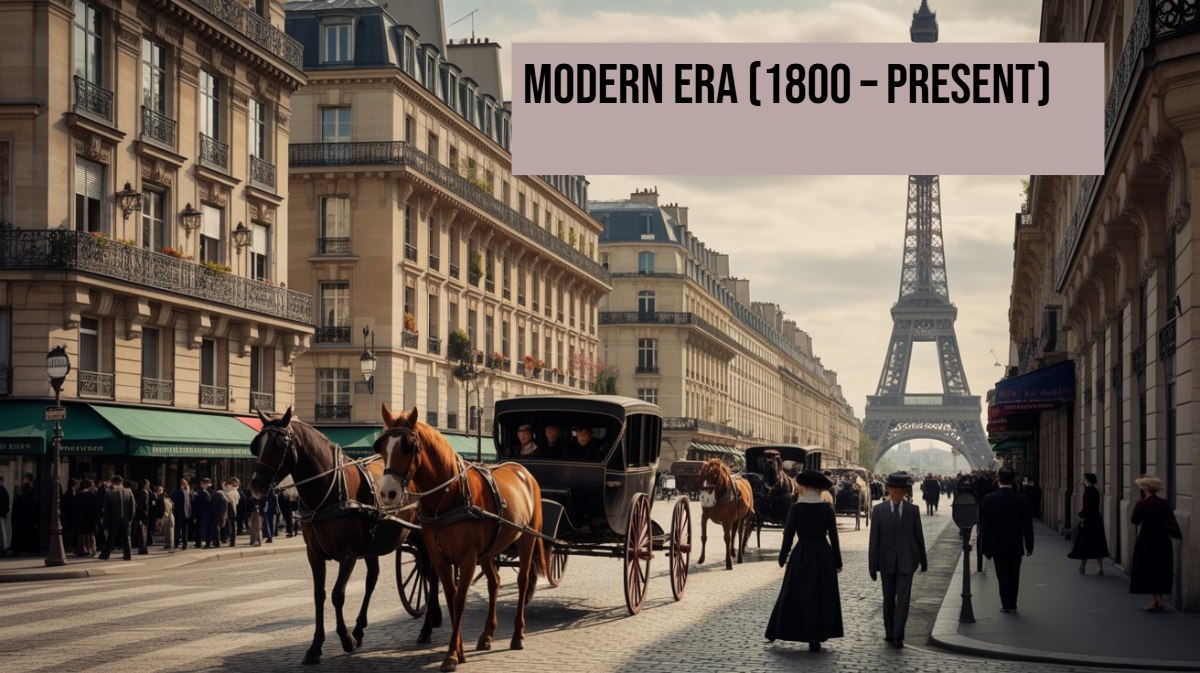
The Modern Era (1800 – Present) stands as the most transformative phase of unfolding World History Timeline, reshaping every aspect of human life. The Industrial Revolution revolutionized economies and societies, sparking rapid urbanization and technological progress. The 20th century witnessed two devastating World Wars, the Cold War, and the emergence of global organizations such as the United Nations. In recent decades, digital revolutions, globalization, and challenges such as climate change and pandemics have continued to redefine the way humanity connects, innovates, and moves forward.
Industrial Revolution & Imperialism (1800 – 1900 AD)
- The Industrial Revolution revolutionized economies.
- 1839–1842 – Opium Wars forced China into unequal treaties.
- 1857 – Indian Rebellion challenges British colonialism.
World Wars (1900 – 1945 AD)
- 1914–1918 – World War I reshapes Europe.
- 1917 – Russian Revolution establishes the Soviet Union.
- 1939–1945 – World War II devastates the globe.
Post-War & Cold War (1945 – 1991 AD)
- 1945 – The United Nations was founded.
- 1947–1991 – Cold War defines geopolitics.
- 1969 – Apollo 11 Moon Landing marks space race victory.
- 1989 – The fall of the Berlin Wall marks the end of Cold War tensions.
Contemporary Era (1991 – Present)
- 1991 – Soviet Union dissolves.
- 2001 – 9/11 Attacks reshape global security.
- 2008 – The global financial crisis hits economies.
- 2011 – Arab Spring spreads democratic uprisings.
- 2020 – COVID-19 Pandemic halts the world.
- 2024 – Climate change & AI dominate global focus.
Why unfolding World History Timeline Matters
unfolding World History Timeline is more than dates—it’s the story of human progress, resilience, and creativity. By studying it, we:
- Understand cultural diversity and shared heritage.
- Comprehend from past mistakes to avoid repeating them.
- Recognize how technological and social changes shape future paths.
Conclusion
unfolding World History Timeline serves as a bridge connecting the past with the present, showing how ancient civilizations, medieval kingdoms, and modern nations have all contributed to the development of human society. By studying these milestones, we gain a deeper appreciation for cultural diversity, innovation, and resilience that continue to shape the world today. History reminds us that progress often comes through struggle, but each era leaves behind wisdom to guide future generations.
At the same time, unfolding World History Timeline emphasizes the interconnectedness of human experiences. From the exchange of ideas along the Silk Road to the global reach of the digital age, it highlights how people across continents have influenced and learned from one another.
As new challenges such as climate change, technological disruption, and global cooperation emerge, understanding history becomes even more vital for building a more united and sustainable future.
Frequently Asked Questions(FAQs)
What is unfolding World History Timeline?
It is a chronological record of human events, civilizations, and significant milestones that have shaped the world from prehistory to the present.
Which event is considered the start of recorded history?
The invention of writing in Mesopotamia around 3000 BCE.
What ended the Medieval Era?
The Fall of Constantinople in 1453 and the Age of Exploration mark the close of this era.
Why study unfolding World History Timeline today?
It helps us understand human development, global connections, and lessons that guide future generations.
Which was the most impactful modern event?
World War II, due to its global destruction and reshaping of political, social, and technological landscapes.
